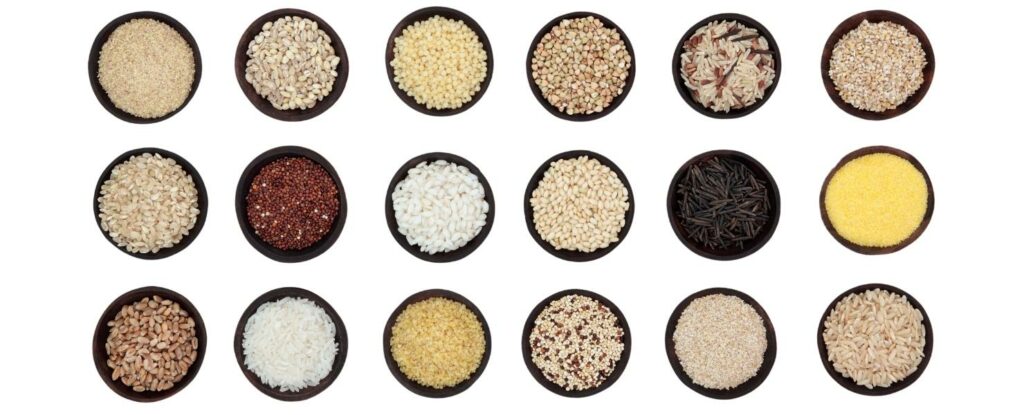Are you eating as healthy as you should? Do you know how much you or the older adult in your life should eat every day from the various food groups? It can be hard to keep up with current nutrition information, which often changes. However, if you follow some basic principles related to the food groups, you’ll come out ahead.
First, here’s a recap of the food groups, as defined by the U.S. Department of Agriculture’s MyPlate:
- Vegetables
- Fruits
- Grains
- Protein
- Dairy
It’s important to eat a well-rounded mix of foods from the various food groups and this might be easier said than done. In fact, it might be a good idea, before or after reading through this article, to consider looking into some of the fantastic meal planning apps and time-saving grocery delivery services out there that can make life a lot easier for you and those that you’re caring for.
Here’s a closer look at the food groups. Find out why each group is important and what some sample servings are.
Vegetables



As the name implies, vegetables are, well, vegetables. However, if you have just a plate of broccoli in mind, then you need to expand your thinking when it comes to vegetables as a food group. The category of vegetables is large, colorful, and packed with nutrition. Here are just some examples of vegetables:
- Leafy greens like spinach and kale
- Carrots
- Sweet potatoes
- Eggplant
- Cauliflower
- Artichokes
- Onions
- Pumpkin
- Beans and peas, which also can fit into the Protein group
There are many reasons why vegetables are an essential part of your diet:
- They are rich in fiber, which will help you stay fuller longer.
- Vegetables have important vitamins like A and C.
- Vegetables like sweet potatoes and tomatoes are rich in potassium, which can help lower your blood pressure.
- They are low in calories and fat.
- They can lower your risk for heart disease and stroke.
Most women age 60 and over should have 2 to 3 cups of vegetables daily, while men should have 2 ½ to 3 ½ cups daily. However, exact amounts from any food group are dependent on your age, height, weight, and physical activity level. Always verify the right amount for you with your doctor or a registered dietitian.
Some examples of one-cup vegetable servings, as shared by MyPlate.gov, include:
- 1 cup of cooked dark, leafy greens or 2 cups of fresh greens
- 2 medium carrots
- 1 large bell pepper
- 1 large sweet potato
- 1 avocado
When you make vegetable choices, it’s OK if you choose frozen over fresh. This often can help you save money, and the frozen choices are just as healthy as the fresh options.
Looking for some new veggies to prepare today? Check out MyPlate.gov’s food group gallery, which lists a variety of choices within each group, including vegetables. Get inspired with new choices you can enjoy. Who knows? You just may find your new favorite veggie.
Fruits



Like vegetables, fruits offer a wide range of health benefits and fit a huge variety of choices. There are the fruits you’ve heard of your whole life, and there are fruits from other regions of the world that may be new for you–but just as yummy and nutritious as your tried-and-true choices. Here are a few examples of fruits:
- Apples
- Bananas
- Oranges
- Papaya
- Mango
- Cantaloupe
- Dried fruit
- Fruit juice
For the last two examples, you’ll want to be careful with how much you consume. Both dried fruit and fruit juice are dense, and they can often pack in extra sugar and calories. Plus, fruit juice does not have the fiber found in whole fruits.
Fruits are an important part of your nutritional needs for several reasons:
- They are rich in fiber. This will help you to feel full faster.
- Fruits have potassium, vitamin C, and folate. Older adults in particular need these nutrients.
- Eating more fruit can help you lower your cholesterol.
- Like vegetables, fruits can reduce your risk for heart disease and stroke.
Women over age 60 should usually aim for 1 ½ to 2 cups of fruit daily; for men, the recommendation is 2 cups. Exact amounts from any food group are dependent on your age, height, weight, and physical activity level. Always verify the right amount for you with your doctor or a registered dietitian.
Some examples of a 1 cup fruit serving include:
- 1 small apple or half of a large apple
- 1 large banana
- 1 cup of blueberries
- 5 figs
- 2 to 3 kiwis
- ½ cup of dried fruit
- ½ cup of fruit juice
As with vegetables, it’s OK to use frozen or canned fruit instead of fresh fruit. However, read the ingredient label to look for no-sugar or low-sugar options.
If you’re looking for new fruit ideas to incorporate onto your plate, check out MyPlate.gov’s food gallery. You’ll be astounded by the many types of fruit, and we’re positive there are some that will be new for you. Cherimoya? Kumquats? Pluots? Loganberries? We’re not making these up! You may just discover a new favorite fruit.
Grains



Grains are a type of food made from things like wheat, rice, oat, rye, or barley. There are a few reasons why grains are an important one of the food groups:
- Whole grains (like whole wheat and whole oats) have fiber to fill you up.
- Whole grains have iron and B vitamins.
- Whole grains are full of magnesium and selenium. Magnesium helps to build bones and release energy from muscles. Selenium is a vital part of a healthy immune system.
One thing to keep in mind with grains is that there are whole grains and refined grains. Many of the grains we eat in the U.S. are refined, which are not as healthy. Refined grains like white bread, white pasta, and white rice have their nutrients and fiber removed; only some of the nutrients are returned after processing. Try to make at least half of your grains whole grains.
Women over age 60 should have 5 to 7 ounces of grains daily, while men should have 6 to 9 ounces.Exact amounts from any food group are dependent on your age, height, weight, and physical activity level. Always verify the right amount for you with your doctor or a registered dietitian.
Some one-ounce grain equivalents include:
- 1 regular slice of bread
- ½ cup of cooked oatmeal
- ½ cup of cooked pasta
- 3 cups of popcorn
- 1 corn tortilla
- ½ of an English muffin
When choosing grains, in addition to emphasizing whole grain choices, seek out grains that are:
- Low in saturated fat
- Have low or no added sugar
- Have no trans fat
Read package labels as low-fat baked goods are sometimes high in added sugar, according to the National Institute on Aging. Look for labels such as “whole wheat” or “whole grain” to indicate a healthier product.
Protein



The protein food group covers a surprisingly wide range of foods, from eggs to beans to seafood to meats. They also have a range of nutritional value. Here are just a few reasons why your protein choices add to your overall nutrition.
- Protein choices are full of iron, which help to prevent anemia.
- Protein gives you energy.
- They have B vitamins and vitamin E.
- Protein choices have zinc and magnesium.
- Some types of seafood, particularly fatty fish like salmon, have heart-healthy omega-3 fatty acids.
One trick with the protein food group is to focus on healthier choices (see below) and steer clear or minimize the less healthy options. The less healthy options have more saturated fats. These include fatty cuts of beef or pork, hot dogs, sausage, bacon, and lunch meats like bologna and salami.
Women age 60 and over should aim for 5 to 6 ounces of protein choices daily. Men age 60 and over should aim for 5½ to 6½ ounces daily. The U.S. Department of Agriculture also advises eating 8 ounces of seafood a week to reap the benefits of omega-3 fatty acids.Seafood that is lower in mercury and that provides healthy omega-3 fatty acids include salmon, shad, and trout.
Exact amounts from any food group are dependent on your age, height, weight, and physical activity level. Always verify the right amount for you with your doctor or a registered dietitian.
One note for vegetarians: Even without eating meat or seafood, it’s still possible to obtain enough protein in your diet. See below for several protein food options. If you are a vegetarian or vegan, you can count foods like beans and lentils as protein sources rather than counting them as vegetables.
Protein food choices for vegetarians include:
- Beans
- Lentils
- Nuts and seeds, including nut and seed butters
- Peas
- Soy products like tofu
Some examples of one-ounce equivalent servings of protein choices include:
- 1 slice of luncheon/deli meats
- 1 ounce of cooked lean beef or pork
- 1 egg
- ¼ cup of cooked beans
- ½ ounce of nuts (for instance, 12 almonds)
- 1 ounce of cooked fish
- 1 tablespoon of nut/seed butter
Dairy



The dairy food group includes foods like milk, yogurt, and cheese, including lactose-free and fortified soy versions of these products.
We need dairy foods as part of our diet for a few health benefits:
- Dairy products are full of calcium, which help to build and maintain strong bones. This is important for older adults.
- Dairy foods produce potassium, and that can help regulate blood pressure.
- Vitamin D, often found in dairy products, also helps to build and maintain strong bones. It does this by helping your body sustain its level of calcium and phosphorus.
Both men and women should get three cups of dairy products a day. However, keep in mind that this does not include some foods made from milk but that are actually high in fat and low in calcium, such as butter, cream, cream cheese, and sour cream.
Exact amounts from any food group are dependent on your age, height, weight, and physical activity level. Always verify the right amount for you with your doctor or a registered dietitian.
Examples of one-cup equivalent servings of dairy products include:
- 1 cup of milk
- 1 cup of calcium-fortified soy milk
- 1 ½ ounces of hard cheese
- ½ cup of ricotta cheese
- 2 ounces of queso blanco
Watch your cheese choices as some cheeses are high in saturated fats.
For those who don’t consume dairy products, some other ways to get calcium include:
- Canned fish like salmon and sardines
- Tahini
- Dark leafy greens
- Calcium-fortified juices and calcium-fortified plant-based milk
What About Other Food Groups, Like Oils or Sweet Treats?



Although some oils used for preparing foods can have health benefits, they are not part of a food group. However, the healthier oils can help you to lower your heart disease risk, improve your “good” cholesterol number (HDL cholesterol), and provide vitamin E.
When choosing oils, consider ones made from natural sources such as:
- Avocados
- Fish
- Nuts
- Olives
Try to avoid fats that are higher in saturated fats such as palm oil or palm kernel oil. It’s also best to limit your intake of solid fats like butter, lard, and shortening. These also are higher in unhealthy saturated fats.
As far as sweet treats go, treats that are high in sugar are not part of a healthy diet. Limit your eating of sweet treats, and watch out for added sugars in all types of food. Read the food labels. Some other types of sugar that you may find in food products include:
- Corn syrup
- Dextrose
- Fructose
- Honey
- Molasses
MyPlate.gov covers a range of topics related to foods beyond those that fit in the food groups.
By following the food groups, you can ensure that you or the older adult in your life is eating healthy to stay strong.







